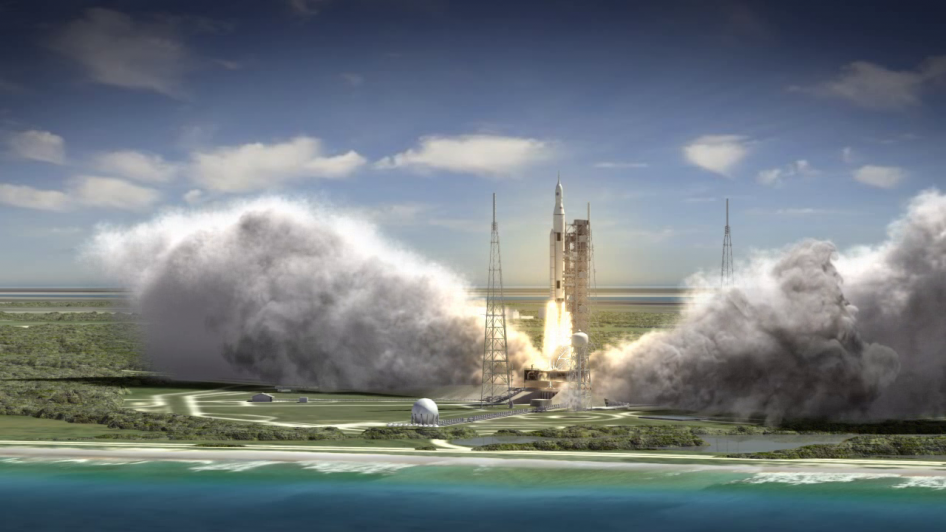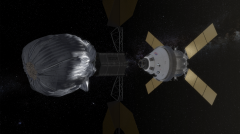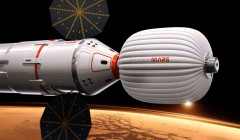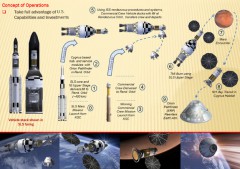
A hearing by the U.S. House of Representatives’ Committee on Science, Space, and Technology, scheduled for Feb. 27, aims to explore the feasibility of a flyby of Mars and Venus as a mission concept for the first manned flight of NASA’s Space Launch System and Orion spacecraft, called Exploration Mission-2 or EM-2, in 2021.
NASA’s newest heavy-lift launch vehicle, the Space Launch System, or SLS, was announced by the space agency at the aftermath of the cancellation of the Constellation program by the White House in 2010, which had the goal of returning astronauts to the surface of the Moon by 2020. Based on the design of the Constellation program’s Ares V rocket, the SLS aims to return a heavy-lift capability to the U.S. space program that was lost following the last flight of the Saturn V rocket in 1973. Yet, ever since the cancellation of Constellation, the future direction of the U.S. human space program has been a subject of intense debate within the space community, with intensive arguments raging over a series of issues like appropriate deep space destinations for future missions, best set of technologies, vision strategies, and the like. Central to this debate has been the overall role of the SLS.

Even though as a launch vehicle SLS is capable of opening up the Solar System to human access, allowing for an endless list of opportunities for both robotic and human missions, as showcased in an earlier AmericaSpace article, only a couple of definitive missions has been officially announced for its launch schedule. The heavy-lift launch vehicle is currently under development and on schedule for its first flight in 2017, called Exploration Mission-1, or EM-1, which will also carry the Orion Multi-Purpose Crew Vehicle, or MPCV, during its second unmanned test flight. NASA’s next-generation human-rated spacecraft for missions beyond low-Earth orbit, Orion, is scheduled to make its inaugural test flight in September of this year onboard a Delta IV Heavy rocket.
NASA currently envisions the first two SLS flights, EM-1 and 2, as part of the agency’s Asteroid Initiative mission proposal, which aims to robotically redirect a small Near-Earth Asteroid into orbit around the Moon by the end of the decade, to be later visited by human crews. The Asteroid Initiative is NASA’s proposal for implementing President Obama’s mandate of sending astronauts to an asteroid by 2025, prior to visiting the vicinity of Mars in the 2030s. To that end, EM-1 is currently scheduled to send an unmanned Orion spacecraft into a seven-day journey around the Moon as a dress rehearsal to evaluate and test all the systems of the whole SLS/Orion integrated architecture in deep space. Four years later, a manned Orion spacecraft is scheduled to approach and dock with the previously captured asteroid in cislunar space, as part of EM-2.
The Asteroid Initiative, however, hasn’t enjoyed much support among the general public, the space sector, and foreign space agencies alike. Furthermore, the U.S. Congress has been largely divided about it as well, with the Senate being silent on the subject and the House of Representatives vehemently opposing it, as evidenced by the two houses’ largely incompatible versions for a 2013 NASA Authorisation Act that were unveiled last year, an agreement on which has remained elusive ever since.
The House’s dissatisfaction with the Asteroid Initiative is further evidenced by the scheduling of a hearing (as reported by the Space Politics website) by the Science, Space, and Technology Committee for 10 a.m. on Feb. 27, which will also be webcast live, titled “Mars Flyby 2021: The First Deep Space Mission for the Orion and Space Launch System?”
As mentioned on the Committee’s web page, the hearing’s witnesses will be:
Dr. Scott Pace, Director of the Space Policy Institute, George Washington University
General Lester Lyles (ret.), Independent Aerospace Consultant and former Chairman of the Committee on “Rationale and Goals of the U.S. Civil Space Program” established by the National Academies
Mr. Doug Cooke, Owner, Cooke Concepts and Solutions and former NASA Associate Administrator for Exploration Systems Mission Directorate
Dr. Sandra Magnus, Executive Director, American Institute of Aeronautics and Astronautics

The idea that the House Committee aims to discuss isn’t a new one. The concept of manned flybys of Mars and Venus have been around since the early days of the Apollo program in the 1960s. There were dozens of studies conducted by NASA and academia during that time concerning such a mission, which was seriously contemplated as a follow-up to the Apollo lunar landings. Space historian David S. F. Portree has chronicled many such mission concepts in his blog Beyond Apollo. “In the 1960s, NASA expended nearly as much study money and effort on manned Mars and Venus flyby mission planning as it did on its more widely known plans for manned Mars landings,” writes Portree. Had things unfolded a bit differently, we could have seen a Saturn V rocket launch such a manned deep-space mission based on Apollo hardware by the end of the 1970s. “The good news is that there’s nothing technologically impossible about a manned Mars mission,” comments Adam Mann on Wired, concerning the prospect of human flights to Mars. “It’s just a matter of deciding it’s a priority and putting the time and money into developing the necessary tools.”
Although neglected for the most part by NASA since the end of the Apollo program, a Mars flyby mission proposal came into the spotlight again early last year during a press conference hosted by billionaire, ex-space tourist, and founder of the non-profit Inspiration Mars Foundation, Dennis Tito. Aiming to inspire the next generation, Tito called for a two-person crew mission to be launched in early 2018 on a low-energy, free-return trajectory toward Mars to fly around the Red planet and return to Earth after a 501-day trip. The specific launch date of 2018 was chosen by Tito after consulting a feasibility analysis study that had been made in the 1990s, which showed that launch windows for very fast flyby missions to Mars which require the minimum amount of fuel (also known as free-return trajectory missions), open every 15 years when Earth and Mars properly align in their orbits. If the 2018 launch window were to be missed, the next opportunity to fly this type of mission would not come until 2031.
Tito has envisioned the mission from the beginning as a not-for-profit, philanthropic expedition. Its costs, estimated to be around $1-2 billion, were hoped to be mostly covered by private donations, while commercial space companies like SpaceX were mentioned as possible providers for the needed hardware.Yet, during a hearing of the space subcommittee of the House Science Committee in November, Tito stressed that Inspiration Mars should essentially be a NASA mission, calling for Congress to provide most of the funding. “Perhaps several hundred million dollars in new federal spending can make this mission happen,” wrote Tito in his testimony to Congress. Besides financial constrains, Tito also acknowledged a series of technical considerations that prompted him to ask for NASA’s partnership on Inspiration Mars: “Analysis of the existing fleet of launch vehicles (aside from SLS) showed that the mission would require three or more launches to get all of the hardware into orbit. The team also found that the planned Commercial Crew spacecraft are not being designed for any missions beyond low earth orbit. Hence, while they could be used to get the crew to orbit, they could not be used as living space or reentry vehicles. NASA in recent years has been perfecting a heavy-lift Space Launch System. With its intended Dual Use Upper Stage, an SLS vehicle – already scheduled for a late-2017 launch – is all that is needed to carry a Mars-mission payload.”

Inspiration Mars’ mission architecture, as outlined by Tito, calls for two launches: one unmanned SLS launch for placing the Inspiration Mars spacecraft into low-Earth orbit, and a second crewed launch of one of the Commercial Crew transportation vehicles that are currently under development to deliver the crew to the Mars-bound spaceship. Following crew delivery, the commercial crew vehicle would be discarded and the Inspiration Mars spaceship would then start its long voyage toward the Red Planet, being propelled out of the Earth’s orbit with the aid of an SLS upper stage.
If the 2018 launch date couldn’t be met, Tito presented Congress with an alternative: “A Plan B, if we need one, is a mission longer by 88 days that flies by Venus before going by Mars, a unique trajectory that could be flown in 2021.” That launch date coincides also with the planned first crewed launch of SLS/Orion.
It’s this alternative, however, that got the attention of Congress. On the upcoming hearing’s charter, published online on the Committee’s web page, it is noted that “last year the Space Subcommittee received testimony from Mr. Dennis Tito, Chairman of the Inspiration Mars Foundation, that indicated that with existing technologies and additional development work, the SLS and Orion could potentially be ready for a Mars flyby by 2021 instead of the 2030s as proposed by the Administration. NASA reviewed the 2018 proposal, but has not reviewed a potential 2021 mission.”
The charter offers some mild criticism for the SLS’s current flight schedule for EM-1 and 2 as well. “In briefings before the Committee, NASA officials have explained the primary driver for NASA’s proposed SLS/Orion schedule, is the out-year budget profile proposed by the Administration, not technology or engineering development.”
Following Tito’s testimony last November calling for NASA’s commitment for the 2018 launch opportunity, the space agency released a statement saying that “it is willing to share technical and programmatic expertise with Inspiration Mars, but is unable to commit to sharing expenses with them. However, we remain open to further collaboration as their proposal and plans for a later mission develop.”
Given the House’s opposition to the Asteroid Initiative, it will be very interesting to see what kind of influence, if any, Tito’s plans for a Mars flyby in 2021 will have on Congress’ overall decision-making process regarding the future path of NASA’s human spaceflight program.
Want to keep up-to-date with all things space? Be sure to “Like” AmericaSpace on Facebook and follow us on Twitter: @AmericaSpace




Great so the Inspiration Mars Mission 2018 is out …But the Inspiration Venus/Mars Mission 2021 is in!!!! This is great news and clearly will generate much more public interest than an Asteroid Mission which is just R&D for Planetary Resources, the company that will start mining asteroids… This is awesome
Intersting concept but I wonder how a 2-person crew would adapt to a relatively confined space for 501 days? Has Tito thought through the full impact of such a mission? I fully support the idea but it must be carefully planned with all contingencies in place.
You’re right Tom.
Actually, this was discussed during the congressional hearing as well – how to best implement this plan, if chosen, and what would be the risks and overall value of such a mission. I plan on writing an update about it next week.
Leonidas
In reviewing video of the committee Hearing I was shocked at how lame the congressional House Science Committee responded to this request…First they complained that this would require public money and in this time of tight budgets where was the money coming from and then they didn’t think 7 years was enough time to build the architecture for a “flyby mission” around Mars….It really made me feel like they just want to spend money on design and fabricate some test vehicles but not launch them because #1 it to expensive and #2 they really don’t know where to go or than an asteroid mission because Planetary Resources really doesn’t want to spend their own money on R&D…Considering the events in the Ukraine and Iran…The world may end before the SLS/Orion goes anywhere other LEO or maybe just maybe to the Moon!!!
Tracy,
You make some valid comments.
You have to remember though, that where we, as space advocates, view things from the scope of advancing humanity’s reach into the Universe, most politicians mostly view things in different terms, centered around a more narrow timeframe – that of election cycles. In all fairness, I also got the impression that some of the members of the committee, showcased real and sincere interest for the space program and want to do good.
What you’re describing is the thing that has made the space program suffer for decades – the absence of will for an ambitious human space exploration, which is a sign of our times. If you recall, all the witnesses testifying in the hearing, stressed that the US could very well manage the challenge of the Mars fly by – provided that NASA is given the focus, political support, funding and a clear rationale as to what it is that we want to achieve in space.
The problems facing NASA’s human spaceflight program aren’t technical, but political ones, so the solution can only be found within politics.